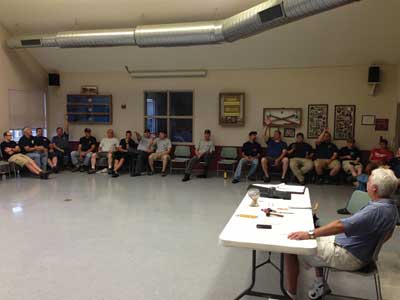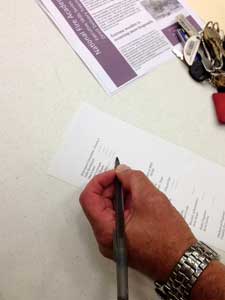By G. HOWARD BLYTHE
Mimicking the country’s strong beliefs of self-determination, volunteer fire departments have held elections to select their leaders for centuries. However, popular elections are not necessarily mechanisms for selecting the most qualified or the best candidate for the position. The popular election does exactly what it states-it selects the candidate who is the most popular. Ask yourself, “How mission effective are our elections?” If you are like most volunteer fire departments, the answer is, “Not as effective as they should be.”
From the days of the Rattle Watch in Dutch New Amsterdam to today, volunteer firefighting efforts have thrived in North America. As our country has evolved, so have the demands placed on its volunteers. However, in the truest sense of dedication and service, the response of the volunteer fire service has similarly evolved. At the beginning of the 21st century, volunteer fire departments are being more closely monitored and regulated than at any other point in their history. This trend will not reverse itself; in fact, the regulations and close scrutiny of service will no doubt increase in the years to come. With 87 percent of U.S. fire departments either all volunteer or mostly volunteer (according to the 2011 needs assessment of the United States Fire Service), the question then becomes, “What is the best method to select leaders who can navigate the difficult times in which we serve?”
During fall 2011 to fall 2012, a study of all-volunteer and mostly volunteer fire departments in the Connecticut area analyzed fire departments serving communities with populations of roughly 3,500 to 30,000. This analysis studied leader selection and command staff structure. Of the fire departments surveyed, the vast majority used some version of a popular election model. Considering the challenging environments in which departments operate, the selection of the leaders of these organizations is crucial. Any person who has spent any length of time in a volunteer fire department knows the shortcomings of the standard popular election system.
The qualifications for fire service officers are mandated by National Fire Protection Association 1021, Standard for Fire Officer Professional Qualifications, although nationally many departments fail to meet this standard. The inherent flaws in the popular election system create a need for departments to find solutions to address the gaps that exist in this process. Several fire departments surveyed instituted programs to help ensure that more qualified and capable candidates were chosen to lead their departments forward.
An example of a department that follows the traditional structure of popular elections is the Old Saybrook (CT) Volunteer Fire Department (OSVFD), which has ascending requirements of number of years served and levels of training to qualify for consideration for officer positions. Many of the certification requirements the OSFVD demands of its candidates are higher than those of many of its counterpart departments in the region. This threshold of certification ensures that individuals who seek to serve their communities in these positions are certified by accredited agencies to a level the department and the authority having jurisdiction find acceptable.
Another department following the traditional model is the Haddam (CT) Volunteer Fire Company (HVFC). The HVFC has a structure similar to that of the OSVFD but without the OSVFD’s level of certification requirements. The HVFC has instituted a unique feature that serves a similar purpose but from a more internal service perspective. The HVFC requires longer periods of service before members become eligible to serve in different leadership roles and requires service at the previous level to serve at the next highest level. This ensures that top leadership has a firm understanding of the workings of the organization at all levels and that it creates a natural mentoring aspect to the structure of the officers.
Both of these systems are traditional-i.e., they conduct elections (photo 1) and, in most cases, the most popular candidate wins. However, both systems work to ensure the qualifications of the eligible candidates to provide the departments and the municipalities with the best possible leaders.
 |
| (1) Haddam (CT) Volunteer Fire Company members hold a standard hand-vote for issue resolution. (Photos by Scott Larson.) |
The Cheshire (CT) Fire Department (CFD), in the early 2000s, recognized that call volume and administration demands were outpacing the abilities of its volunteers. An internal restructuring was initiated to accommodate a combination department structure. Once this restructuring was complete, the department approached Cheshire administrators to initiate the conversion to a combination department. The conversion would first address the department administratively and then operationally as the needs dictated. Cheshire administrators supported the institution of a paid chief and an administrative staff.
In 2004, the CFD was officially created, and the paid chief position was filled. The chief is the chief operating officer of the organization, and the fire marshal and the administrative staff are the only employees. The volunteer fire department incorporated itself and contracted with the town to supply the staffing for the fire department. Although the chief administers the department on a day-to-day basis and commands the units during emergency operations, he retains only an advisory position over the running of the incorporated volunteer department. Some responsibilities that fall to the chief are the establishment of policies and procedures the volunteers must follow. This removes him from direct control over personnel issues that, in some instances, may result from policies and procedures he has instituted. This very innovative structure allows the volunteer department to hold elections for its own internal leaders, preserving the group’s desire for self-determination while taking overall direction and mandates from an external guiding organization.
Managing an organization structured this way poses many challenges. However, it is a great example of an organization self-evaluating and thinking outside the box for a solution that is proactive and forward looking. The honest self-evaluation hurdle is the first and, usually, the most difficult to overcome.
The Newington (CT) Fire Department (NFD) abandoned the traditional model of popular elections in the late 1980s. The NFD had concluded that officers were making decisions based on getting reelected as opposed to focusing on making the best decisions for the future of the organization. In 1990, the board of fire commissioners adopted a system to appoint chief officers. Once the department’s top leadership is appointed, the appointees select the first and second line officers to serve under them. The chief officers are given tasks to accomplish, and they select the people they feel are best suited to help accomplish those tasks.
These officers serve for a term of three years; the process for appointment to those spots is similar to applying for a job. Each candidate submits a resume, which is considered along with reviews done on each candidate by colleagues and subordinates. The candidates are interviewed, and the commission makes its appointments. If an officer wishes to continue at the particular position after serving his term, he reapplies and interviews for reappointment to that position.
The NFD does not have specific levels of training required for service at each rank. However, it continually attracts leaders who are more certified than many of the other departments surveyed. This, in part, is a result of the department being a pay-per-call fire department and the stipend being higher for officers. As a result, the desire for the higher pay and knowing you need a more robust resume than other candidates create an atmosphere of pursuit of higher certification and training levels without a written mandate.
One other feature of this model is the transfer of risk from the fire department to the town through the board of fire commissioners. By having the leadership selected by an elected town board instead of internally, the process gives a level of transparency and control to the town administrators. This helps eliminate the possibility of the fire department being accused of misfeasance or malfeasance when selecting its leaders.
Of all of the departments surveyed, only one reported any level of town administration or oversight beyond a basic accountability and responsibility to the approved budget. In Cheshire, the chief reported working in a system of management by objective. The chief was assigned tasks to complete by Cheshire administrators and was reviewed on his performance of those tasks. All other communities had an extremely hands-off and uninformed view of what the fire department did for their communities from day to day. In Cheshire, the more engaged approach of the town may be a result of the department asking the town for help in the early 2000s. Prior to that meeting, which was initiated by the fire department, the town administrators were not aware there were any issues with the fire department.
This dynamic of “uninformed bliss” exists in most municipal administrative bodies. As long as the budget is administered within their parameters, municipal leaders have no further knowledge of the mission or its challenges. From their perspective, as long as “the big door goes up and a truck with flashing lights pulls out,” everything must be fine. The responsibility falls on the fire service leaders to perform honest self-assessments and act responsibly in the municipality’s best interest (photo 2).
 |
| (2) A secret ballot to fill open positions. |
As the political and social atmosphere in which fire departments operate evolves, the fire service must evolve to keep pace. The four departments covered here each took varying proactive steps to address the future needs of their departments. Taking a more strategic human resources approach to your own future by creating a “pipeline” of future leaders is imperative. The alternative of “passive successive leadership” perpetuates an environment that often constricts departments and undermines future successes.
The steps these departments took range from specific certification and qualification requirements to progressive leadership paths, 360° evaluations, and third-party appointments. All are examples of actions that you can take to more progressively ensure an effective future for your organization. As with all issues within our organizations, the first step in changing our current situation is an acknowledgement of the need for change. Using any one of these models or any combination of examples to suit the specific needs of a particular department is preferable to inaction. The available solutions are only as limited as the organization’s willingness to explore solutions.
Author’s note: Special thanks to CFD Chief of Department Jack Casner, NFD Chief of Department Chris Schroeder, HVFC Chief of Department Gary Klare, and OSVFD Chief of Training Tim Lucas.
G. HOWARD BLYTHE is a 15-year firefighter with the Fire Department of New York currently assigned to Ladder Company 27 in the Bronx. Previous assignments include Ladder Company 15 and Ladder Company 113. He has a bachelor of arts degree from John Jay College in New York and a master of science degree from Oklahoma State University. He is a nationally certified fire instructor III and fire officer IV. Blythe also works as a program coordinator for the Connecticut Fire Academy and an adjunct lecturer at the University of New Haven. He was a volunteer firefighter and officer for 15 years.
Fire Engineering Archives

